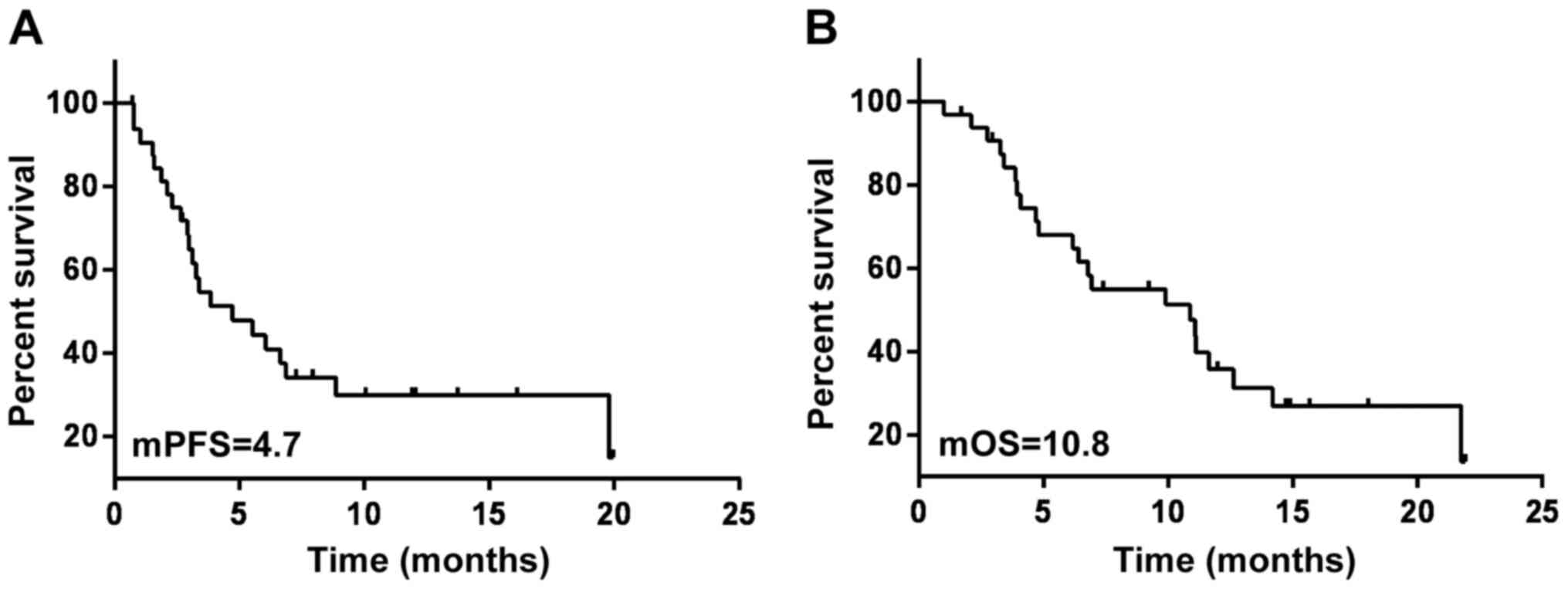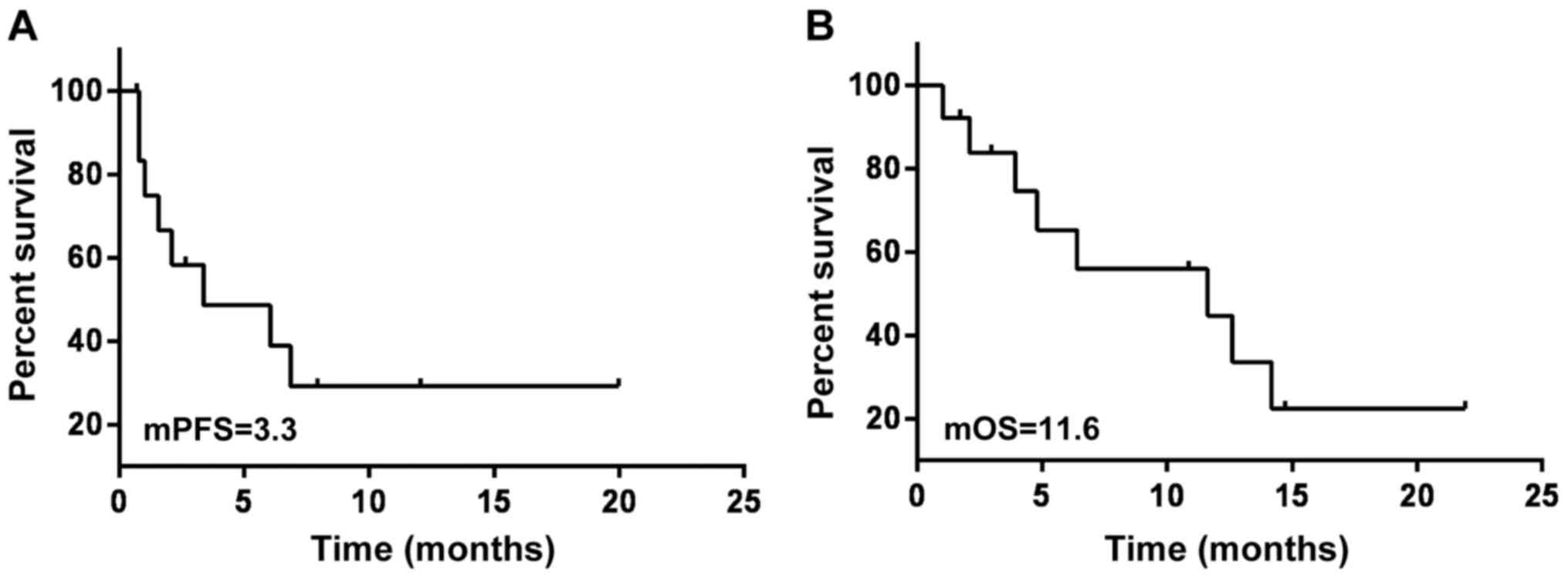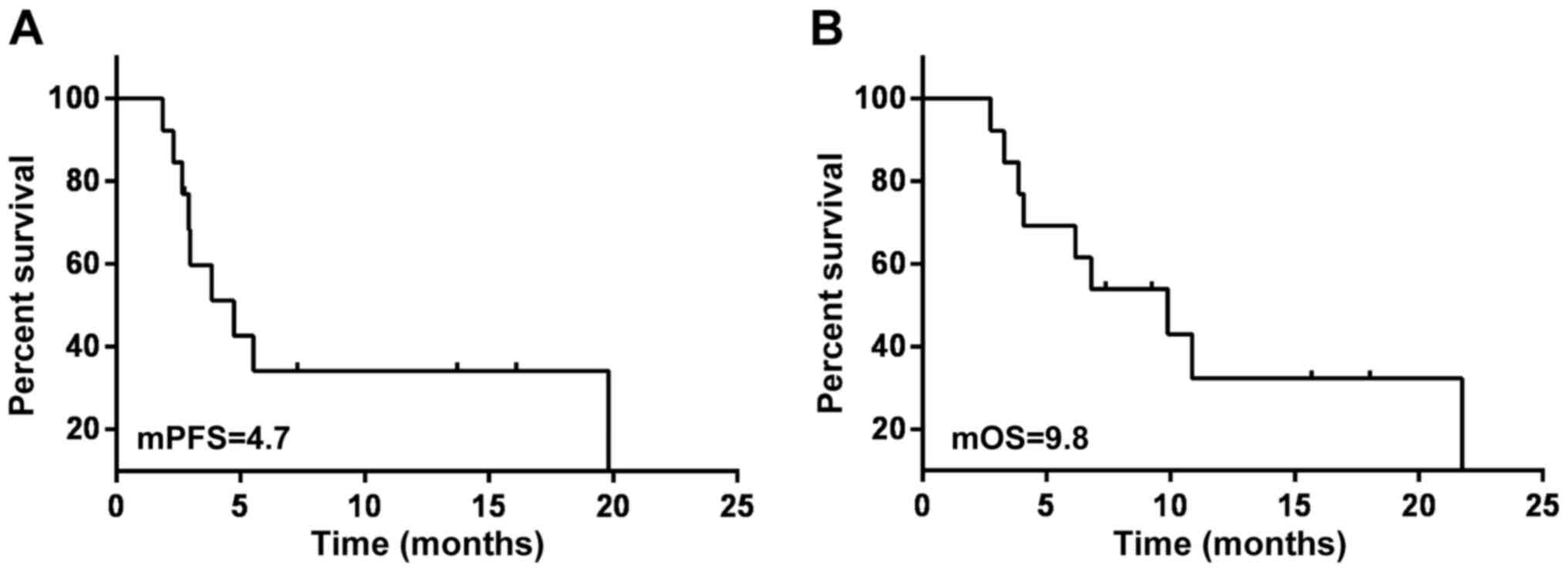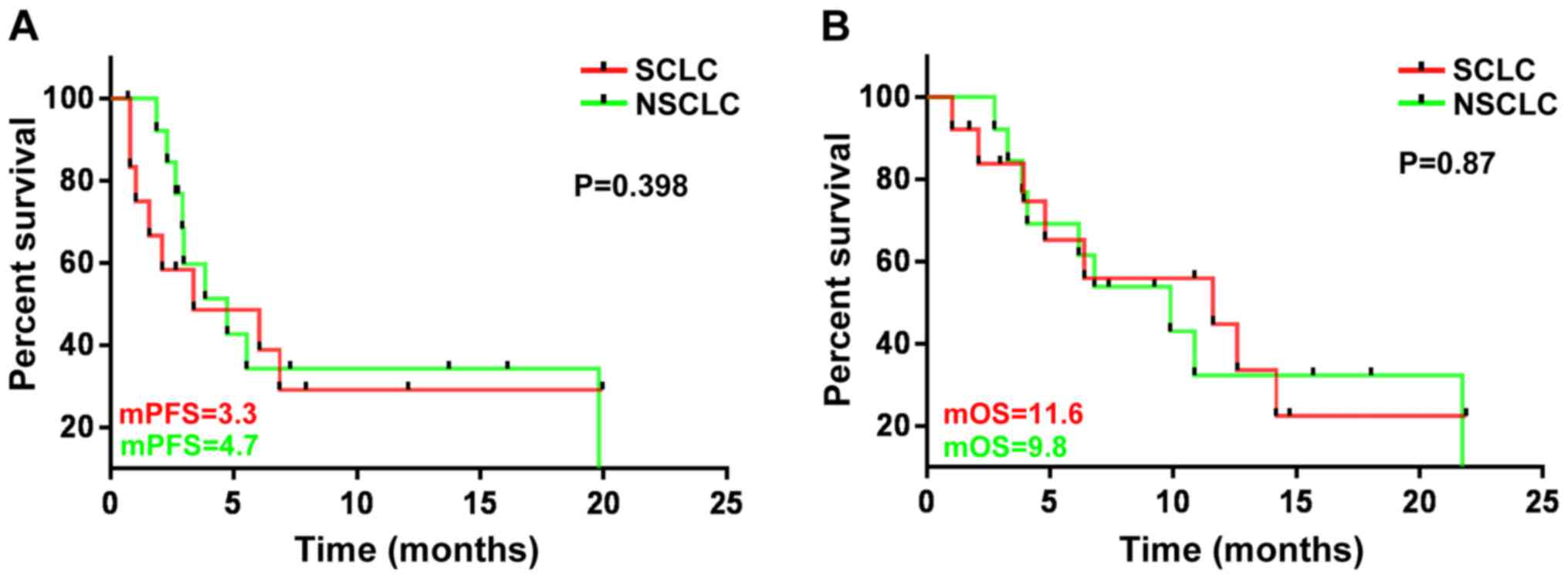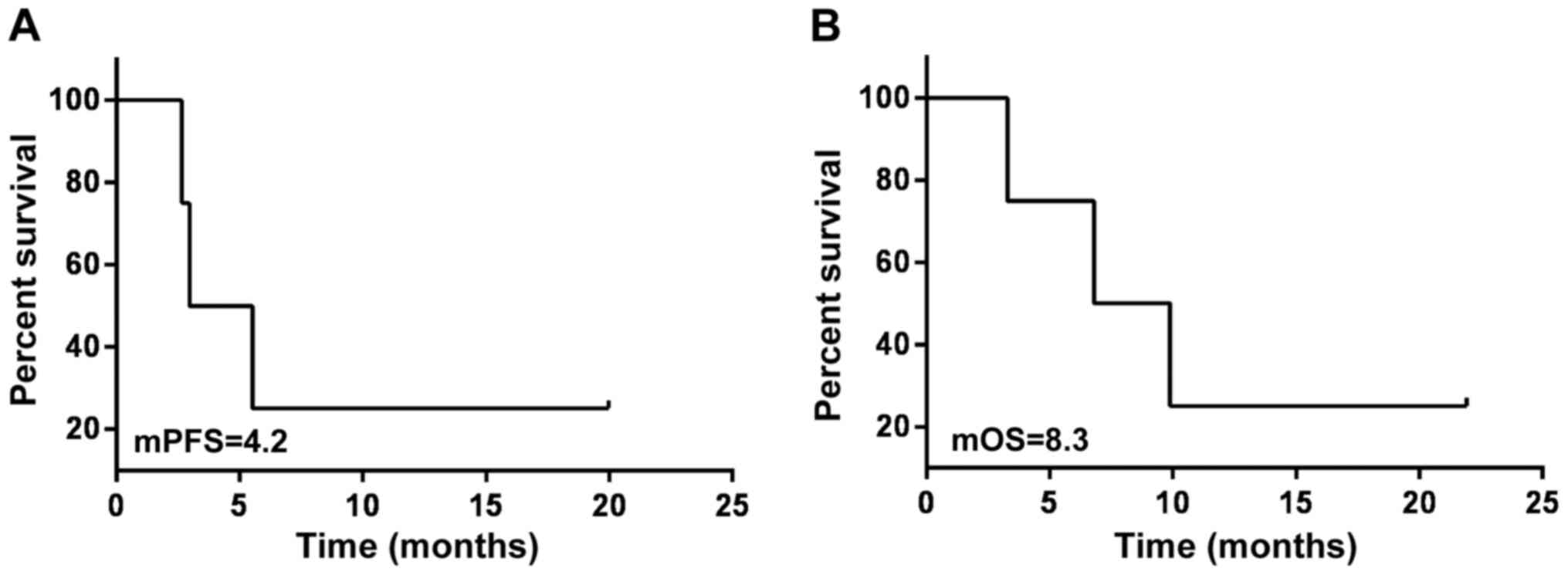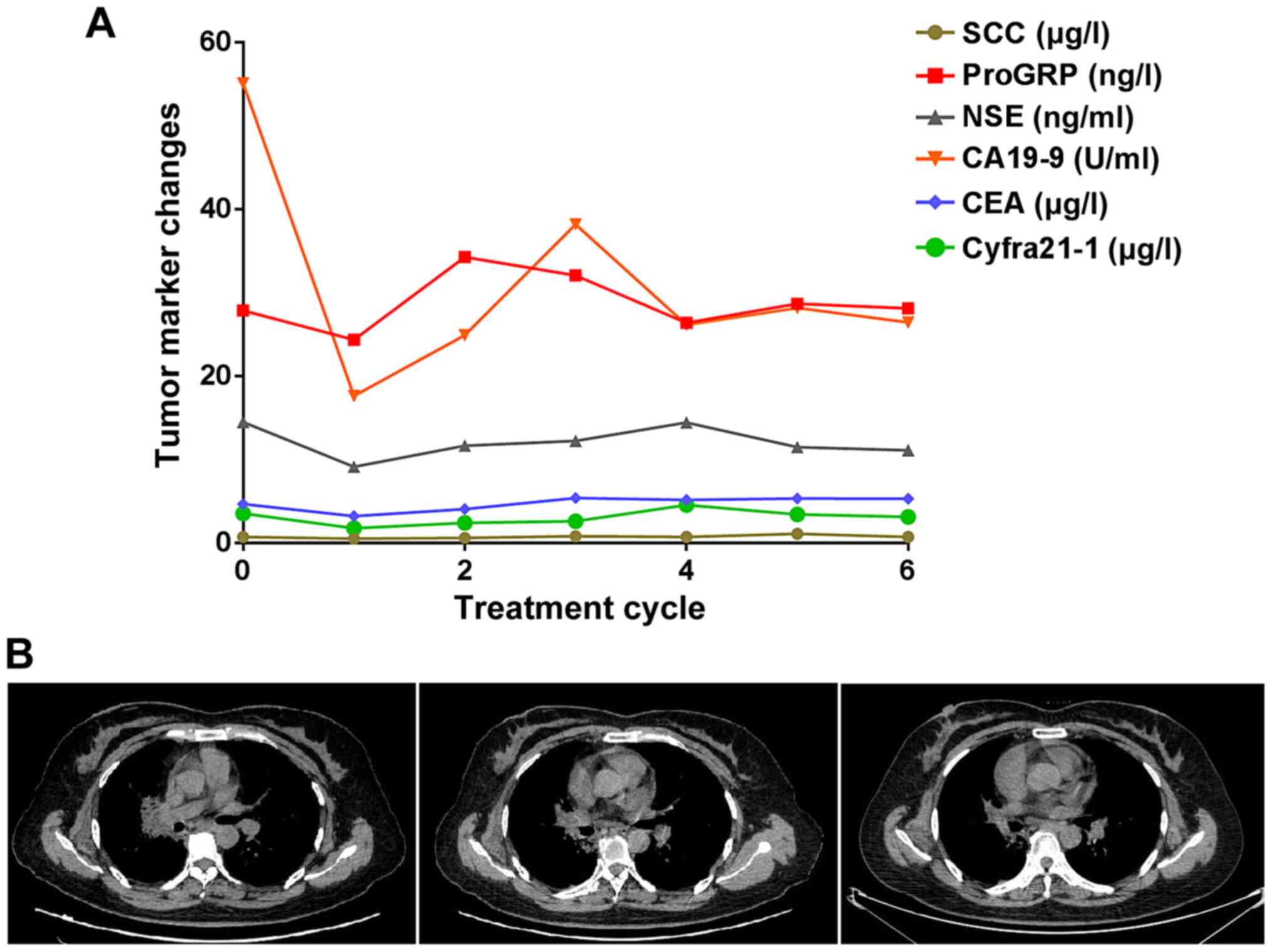Safety of apatinib plus S‑1 for advanced solid tumor as palliative treatment
- Authors:
- Published online on: November 19, 2020 https://doi.org/10.3892/etm.2020.9494
- Article Number: 62
-
Copyright: © Chen et al. This is an open access article distributed under the terms of Creative Commons Attribution License.
Abstract
Introduction
An estimated 4,292,000 new solid tumor cases and ~2814,000 solid tumor-associated deaths were reported in China in 2015(1). In general, surgery is the most efficient therapy for early-stage tumors, but most of the patients experience relapse after radical surgery (2). Furthermore, targeted therapy and immunotherapy are suitable for specific populations and certain patients may develop drug resistance after treatment. Multi-line chemotherapy and local radiotherapy are recommended as salvage treatments for these recurrent and refractory tumors and no alternative treatment is available for these patients, but they may respond to salvage treatment (3).
Tumor cells require nutrients to support proliferation, growth and metastasis, which causes abundant new blood vessels to develop (4). Aberrant angiogenesis is considered to be the key feature of tumorigenesis, and therefore, tumor growth may be suppressed by blocking this process (5). The vascular endothelial growth factor (VEGF) pathway is crucial in angiogenesis, with VEGF receptor-2 (VEGFR-2) being the leading signaling receptor involved in this pathway (6,7). Apatinib, a small-molecule inhibitor of VEGFR-2, is an orally bioavailable agent that is currently being studied in multiple tumor types. It may significantly inhibit angiogenesis of tumors and was proven to be well-tolerated, safe and effective in the clinic (8). Apatinib has shown favorable results in gastric cancer, breast cancer, lung cancer and esophageal cancer in Phase I/II/III trials, with secondary hypertension, hand-foot syndrome, fatigue and positive urine protein being the most frequent treatment-associated adverse events (9-17). S-1(Tegafur Gimeracil Oteracil Potassium Capsule) is a combination of novel oral fluoropyrimidine-based agents, exhibiting potent antitumor activity and low gastrointestinal toxicity (18). Monotherapy with S-1 has provided a high degree of relief for patients with various types of advanced tumor (19). In fact, >90% of patients with malignant tumors succumb due to multidrug resistance (MDR) (20,21). Apatinib is able to reverse MDR by inhibiting ATP binding cassette transporters (22). Thus, apatinib combined with traditional chemotherapy drugs may achieve effective results and protect against the emergence of MDR. Therefore, the safety and efficacy of apatinib combined with S-1 in patients with advanced cancer were explored in the present study.
Materials and methods
Patient eligibility
From April 2016 to March 2019, patients with advanced cancer who failed two or more lines of chemotherapy and were then treated with apatinib combined with S-1 at Tianjin Medical University Cancer Hospital (Tianjin, China) were retrospectively evaluated. The key inclusion criteria were as follows: i) Patients with malignant tumors, age ≥18 years; ii) patients who had received second-line treatment (radiotherapy or chemotherapy), and were refractory or had relapsed iii) at least one measurable lesion; iv) Karnofsky performance status (KPS) ≥80 at enrollment; v) failed to tolerate another chemotherapy; vi) took the combination of apatinib and S-1 for at least one cycle. All patients provided written informed consent and the present study was approved by the Ethics Committee of Tianjin Medical University Cancer Hospital (Tianjin, China). The trial is registered at ClinicalTrials.gov (no. NCT04128800).
Treatment methods
All patients received oral apatinib 250 mg once plus S-1 60 mg/m2 twice daily on days 1-14, repeated every 3 weeks. The examination of hematological, liver and kidney function, urinalysis, tumor markers and electrocardiogram were routinely performed during treatment with apatinib plus S-1 and all patients had a reassessment after every treatment cycle. The color ultrasound of the upper abdomen and neck lymph nodes, bone scan, enhanced CT of the chest and MRI of the brain were performed every two cycles. In the meantime, adverse reactions of patients were recorded in detail, including myelosuppression, nausea and vomiting, hand-foot syndrome (HFS), fatigue, proteinuria and hypertension, prior to and after each taking the drug cycle. During treatment, if a patient experienced grade 3 or 4 neutropenia or thrombocytopenia, recombinant human granulocyte colony-stimulating factor or interleukin-11 was administered by subcutaneous injection. Treatment was continued until disease progression or the occurrence of intolerable adverse effects. Of note, patients with a bleeding tendency were closely monitored.
Outcome assessments
Complete response (CR), partial response (PR), progressive disease (PD) and stable disease (SD) were defined according to the Response Evaluation Criteria in Solid Tumors 1.1 (RECIST guideline version 1.1). The objective response rate (ORR) was defined as ORR=CR+PR rates. The disease control rate (DCR) was defined as DCR=CR+PR+SD rates. Toxic reactions were assessed in accordance with the National Cancer Institute-Common Toxicity Criteria for Adverse Events version 4.0 (NCI-CTCAE guideline version 4.0).
Progression-free survival (PFS) time was defined as the time from the first day of each treatment cycle to the first found evidence of PD on imaging. Overall survival (OS) time was defined as the time from the first day of each treatment cycle to the time-point of death or the last follow-up of patients.
Statistical analysis
SPSS version 24.0 (IBM Corp.) was used for statistical analysis. Only patients who received at least one cycle of treatment were included in the analysis. The association between the patients' characteristics and curative effects was analyzed using the χ2 test. The association between clinical characteristics and severe adverse effects was also analyzed using the χ2 test. Survival analysis was performed using the Kaplan-Meier method by log-rank test. P<0.05 was considered to indicate a statistically significant difference.
Results
Patient characteristics
A total of 33 patients were enrolled in the present study. Their baseline characteristics are summarized in Table I. Among them, 22 patients were male and 11 were female with a median age of 60 years (range, 40-77 years). There were 13 (41.9%) patients with NSCLC and also 13 (41.9%) patients with SCLC. The NSCLC patients included 7 patients (21.2%) with adenocarcinomas and 6 (18.2%) with squamous-cell carcinomas; furthermore, there were 3 patients (9.1%) with cervical cancer and 4 patients (12.1%) with esophageal cancer. Prior to receiving their treatment as part of the present study, 32 patients (97.0%) had received palliative chemotherapy, 26 (78.8%) had received radiotherapy, 12 (36.4%) had received concurrent chemoradiotherapy and only 2 patients (6.1%) had undergone surgery. A total of 114 cycles of treatment were recorded, with a median of 3 cycles per patient (range, 1-6 cycles). The characteristics of the patients in the concurrent chemo-radiotherapy group are presented in Table SI.
Adverse effects
As presented in Table II, the most common treatment-associated toxic effects and adverse events were anemia (23.7%), hypertension (22.8%), leukopenia (19.3%), increase of bilirubin (15.0%) and proteinuria (13.0%). These side effects were of grade 1-2 and were tolerable and controllable. However, the incidence of other side effects, including thrombocytopenia, nausea, HFS, hemorrhagic tendency and diarrhea, were low. As presented in Table III, all of the 33 patients had experienced toxicities and side effects and 15 of them had severe adverse effects (grade 3-4) with an incidence rate of 45.5%. The top three severe adverse effects (grade 3-4) were hypertension (15.2%), thrombocytopenia (12.1%) and proteinuria (9.1%). As presented in Table IV, there was no significant association with age, gender, KPS score, treatment cycles and cancer type. A total of 5 patients discontinued treatment after cycle 1, which was due to disease progression in 3 cases and due to unknown reasons in 2 cases. Furthermore, 5 patients discontinued treatment after two cycles, which was due to personal will in 3 cases, due to cerebral embolism in 1 case and due to radiation pneumonia in 1 case. The treatment-associated toxicities and side effects in all these patients were mild and manageable.
Table IVAssociation between clinical characteristics and adverse effects in patients with advanced solid tumor treated with apatinib plus S-1. |
A total of 2 deaths (6.1%) were recorded during the treatment. These 2 patients with lung squamous-cell carcinomas died of massive hemorrhage instead of disease progression after four and two cycles of treatment, respectively. Both of these were treatment-associated deaths.
Therapeutic outcomes and survival analyses
Until March 01, 2019, 22 of the patients of the present study had died and 11 survived. The disease had progressed in 9 cases and 24 had no disease progression. No CR was achieved and 10 patients achieved PR, resulting in an ORR of 30.30%. Furthermore, 14 patients achieved SD and 9 patients had PD, resulting in a DCR of 72.73%. The 13 patients with NSCLC had an ORR and DCR of 30.77 and 84.62%, respectively. Furthermore, the 13 patients with SCLC had an ORR of 30.77% and a DCR of 53.85%. The ORR of the patients with cervical cancer was25% and the DCR was 75%. Patients with esophageal cancerhad an ORR of 33.33% and a DCR of 100%. However, for patients with advanced NSCLC and SCLC, there was nosignificant difference in DCR or ORR among the age groups,gender groups, KPS score groups and treatment cycle groups(Tables V and VI). The treatment efficacy for the 3 patients with cervical cancer and 4 patients with esophageal cancer is presented in Table VII.
Table VAssociation between clinical characteristics and curative effect in patients with small-cell lung cancer treated with apatinib plus S-1. |
Table VIAssociation between clinical characteristics and curative effect in patients with non-small cell lung cancer treated with apatinib plus S-1. |
For all patients receiving oral apatinib combined with S-1 therapy, the follow-up data suggested that the median PFS (mPFS) was 4.7 months and the median OS (mOS) was 10.8 months (Fig. 1). The mPFS of the 13 patients with SCLC was 3.3 months and the mOS was 11.6 months (Fig. 2). The mPFS of the 13 patients with NSCLC was 4.7 months and the mOS was 9.8 months (Fig. 3). There was no significant difference in the mPFS and mOS between the SCLC and NSCLC patients (P=0.398 and 0.87, respectively) (Fig. 4). For the patients treated with radiotherapy during medication, the follow-up data suggested that the mPFS and mOS was 4.2 and 8.3 months, respectively (Fig. 5). Furthermore, the mPFS and mOS of the 4 patients with esophageal cancer was 9.2 and 12.9 months, respectively. The mPFS and mOS of the 3 patients with cervical cancer was 3.2 and 6.9 months, respectively (data not shown). In Fig. 6, a representative case of a patient with lung adenocarcinoma in whom a good effect was achieved is presented. After taking the medicine for 2, 4 and 6 cycles, the CT reexamination showed that the lesions were diminished than prior to taking the medicine and the tumor markers were also reduced.
Discussion
The present study was the first to evaluate the curative effect and safety of apatinib and S-1 in the treatment of refractory and recurrent solid tumors, to the best of our knowledge. The total DCR was 72.7% and the incidence rate of adverse effects (grade 3-4) was 45.5%. The major side effects were hypertension, thrombocytopenia and proteinuria. In brief, apatinib combined with S-1 appeared to be effective and relatively safe in the treatment of solid tumor, but caution should be taken for patients with squamous-cell lung carcinoma.
Targeted therapy, immunotherapy, radiotherapy and chemotherapy are standard treatments for most types of carcinoma (23). A previous study indicated that the ORR and DCR was 42.2 and 51.5% in patients with NSCLC who received apatinib treatment (250 mg/day) (24). In comparison, the present study suggested that the ORR and DCR of the 13 patients with NSCLC were 30.77 and 84.62%; for the 13 patients with SCLC, the ORR and DCR rates were 30.77 and 53.85%, respectively. In the present study, the efficacy of apatinib combined with S-1 was confirmed and a significant antitumor effect was observed in patients with advanced lung cancer. However, the mPFS and mOS of the patients of the present study was only 3.3 and 11.6 months, respectively, which was considered similar to another study (25). As an example, in a single-center retrospective study, 23 cases of extensive-stage SCLC had received apatinib as maintenance therapy and the mPFS and mOS was 4.1 and 12.5 months, respectively (25). A major reason may be that the patients with SCLC in the present study who received multi-course treatment had a poor KPS score.
VEGF is highly expressed in numerous types of solid tumor (26), which has an important role in promoting endothelial cell survival and maintaining vascular integrity. Bleeding is a common adverse reaction of VEGFR inhibitor, which may be directly related to the inhibitory effect of the VEGF signaling pathway (27). Apatinib, targeting the VEGF signaling pathway, has been indicated to be a promising treatment for numerous types of cancer in preclinical and clinical trials (28). The majority of these patients (n=24; 72.7%) exhibited tumor shrinkage or stabilization, which is better than the effect of other VEGFR-TKIs. The potential reasons may be as follows: i) When combined with chemotherapy, inhibition of VEGF may impair the ability of endothelial cells to repair or regenerate during tumor shrinkage, resulting in an increased risk of bleeding (29). As an example, the SD rate reported in a phase-I study of sorafenib for advanced refractory solid tumors was only 26% (30). In a pooled analysis of 137 patients with advanced refractory solid tumors in 4 phase-I trials of sorafenib, only 2 patients (1.4%) achieved PR and 38 (28%) achieved SD, while the majority of patients (70.8%) exhibited PD on radiological imaging (31). ii) The combination treatment S-1 was proven effective in the treatment of certain types of solid cancer, including gastric (32), breast (33), colorectal (34) and pancreatic (35) cancer, and NSCLC (36). S-1 is a combination of the fluoropyrimidine-based anticancer agent tegafur (FT) as the effector drug with two modulators, 5-chloro-2,4-dihydroxypyridine (CDHP) and potassium oxonate (Oxo), at a molar ratio of 1:0.4:1(37). The degradation of FT-derived 5-fluorouracil (5-FU) is inhibited by CDHP, resulting in enhancement of the antitumor effect (38,39). Oxo reduces the gastrointestinal toxicity of 5-FU. After its oral administration, Oxo is distributed selectively to the small and large intestines, thereby reducing the incidence of diarrhea (40). A phase-II trial determined that the adverse event profile of the combination S-1 was neutropenia (10.3%), leukopenia (13.8%), anemia (3.4%) and thrombocytopenia (3.4%) (41).
In the present study, anemia, hypertension, leukopenia, increase of bilirubin, proteinuria and HFS were the most common treatment-associated toxicities. Among them, the incidence rate of grade 3-4 anemia, leukopenia and thrombocytopenia was only 6.1, 6.1 and 12.1%, respectively. Most of the remaining adverse events were not severe and controllable (grade 1/2). These side effects may mainly be due to apatinib. While 69% of patients in the present study experienced myelosuppression, the cause of bone marrow suppression is the presence of VEGF receptors on bone marrow progenitor cells (42). Although 66.7% of the patients experienced hypertension, it was easy to lower blood pressure with medication. The key mechanism of hypertension is thought to be that VEGF inhibition diminishes nitric oxide synthesis and promotes vasoconstriction, thereby increasing peripheral resistance (43). Although 36.4% of patients experienced an increase of bilirubin, this was transient and disappeared gradually after the treatment was terminated. Furthermore, the incidence of HFS and proteinuria was low and of grade 1 or 2 in most cases. Of note, a patient with cervical cancer developed grade-3 HFS after taking two cycles of medication. A study has indicated that the mechanism is still unclear and may not be produced by blockade of the epidermal growth factor receptor, but rather by effects on intracellular downstream pathways (44). The use of lotions or moisturizers may help ease symptoms. In the present study, two patients died of massive hemorrhage, but neither of them had PD according to CT scan. This may be associated with the location of the lesion, which was close to the aorta in those patients. Therefore, apatinib should be used in patients with squamous-cell lung carcinoma with caution. Similar side effects have been reported for bevacizumab (avastin) and sunitinib malates (sutent, sorafenib and nexavar) (27,45-47). In the case of cough or high pressure in the thoracic region, massive hemoptysis due to the broken integrity of the vessel wall may be present. Thereby, the safety of apatinib in patients with advanced squamous-cell carcinoma may be worthy of recognition. The underlying mechanisms of treatment-associated pulmonary hemorrhage and its possible clinical risk factors should be further explored. It was indicated that squamous-cell histology, tumor erosion, necrosis or cavitation, tumor location close to major blood vessels or trachea may be considered as potential risk factors for apatinib-associated hemorrhage.
Of note, the present study had certain limitations. First, as it was an exploratory study, only a small number of patients were recruited without the availability of any better treatments, which may lead to unreliable statistical results. Furthermore, PFS and OS analysis were performed among different groups, but it may not be possible to generalize the conclusions from the subgroup analyses within the small heterogeneous cohort. It is necessary to perform further studies in the future.
In conclusion, the present study indicated that the combination of apatinib and S-1 had manageable toxicities and promising efficacy in patients with recurrent and refractory solid tumors, but the regimen should be used with caution in patients with squamous-cell lung carcinoma.
Supplementary Material
Characteristics of patients subjected to radiotherapy during medication.
Acknowledgements
Not applicable.
Funding
This study was supported by a grant from the National Natural Science Foundation of China (grant no. 81372518 to PW) and the Tianjin Science and Technology Commission Project (grant no. 16JCYBJC25300 to NL).
Availability of data and materials
The datasets used and/or analyzed during the present study are available from the corresponding author on reasonable request.
Authors' contributions
SC, JS, HL, JL and DJ collected the clinical cases; SC performed statistical analysis; NL designed the study and obtained funding; SC drafted the manuscript; and LZ, YGS, YCS provided the cases and revised the manuscript. All authors read and approved the final manuscript.
Ethics approval and consent to participate
All procedures in studies involving human participants were performed in accordance with the ethical standards of the institutional research committee and with the 1964 Helsinki Declaration and its later amendments or comparable ethical standards. This study was approved by the Tianjin Medical University Cancer Institute and Hospital Human Research Ethics Committee (Tianjin, China). Comprehensive informed consent was obtained from all subjects.
Patient consent for publication
Not applicable.
Competing interests
The authors declare that they have no competing interests.
References
|
Chen W, Zheng R, Baade PD, Zhang S, Zeng H, Bray F, Jemal A, Yu XQ and He J: Cancer statistics in China, 2015. CA Cancer J Clin. 66:115–132. 2016.PubMed/NCBI View Article : Google Scholar | |
|
van Hagen P, Hulshof MC, van Lanschot JJ, Steyerberg EW, van Berge Henegouwen MI, Wijnhoven BP, Richel DJ, Nieuwenhuijzen GA, Hospers GA, Bonenkamp JJ, et al: Preoperative chemoradiotherapy for esophageal or junctional cancer. N Engl J Med. 366:2074–2084. 2012.PubMed/NCBI View Article : Google Scholar | |
|
Song Z, Yu X, Lou G, Shi X and Zhang Y: Salvage treatment with apatinib for advanced non-small-cell lung cancer. Onco Targets Ther. 10:1821–1825. 2017.PubMed/NCBI View Article : Google Scholar | |
|
Carmeliet P and Jain RK: Angiogenesis in cancer and other diseases. Nature. 407:249–257. 2000.PubMed/NCBI View Article : Google Scholar | |
|
Roudsari LC and West JL: Studying the influence of angiogenesis in in vitro cancer model systems. Adv Drug Deliv Rev. 97:250–259. 2016.PubMed/NCBI View Article : Google Scholar | |
|
Ferrara N, Gerber HP and LeCouter J: The biology of VEGF and its receptors. Nat Med. 9:669–676. 2003.PubMed/NCBI View Article : Google Scholar | |
|
Ebos JM, Bocci G, Man S, Thorpe PE, Hicklin DJ, Zhou D, Jia X and Kerbel RS: A naturally occurring soluble form of vascular endothelial growth factor receptor 2 detected in mouse and human plasma11ontario graduate scholarship in science and technology (J.M.L. Ebos); sunnybrook trust for medical research (G. Bocci); and NIH grant CA41223, Canadian institutes for health research, and national cancer institute of Canada (R.S. Kerbel). Mol Cancer Res. 2:315–326. 2004. | |
|
Geng R, Song L, Li J and Zhao L: The safety of apatinib for the treatment of gastric cancer. Expert Opin Drug Saf. 17:1145–1150. 2018.PubMed/NCBI View Article : Google Scholar | |
|
Brower V: Apatinib in treatment of refractory gastric cancer. Lancet Oncol. 17(e137)2016.PubMed/NCBI View Article : Google Scholar | |
|
Ding L, Li QJ, You KY, Jiang ZM and Yao HR: The use of apatinib in treating nonsmall-cell lung cancer: Case report and review of literature. Medicine (Baltimore). 95(e3598)2016.PubMed/NCBI View Article : Google Scholar | |
|
Li F, Liao Z, Zhao J, Zhao G, Li X, Du X, Yang Y and Yang J: Efficacy and safety of Apatinib in stage IV sarcomas: Experience of a major sarcoma center in China. Oncotarget. 8:64471–64480. 2017.PubMed/NCBI View Article : Google Scholar | |
|
Scott A, Messersmith W and Jimeno A: Apatinib: A promising oral antiangiogenic agent in the treatment of multiple solid tumors. Drugs Today (Barc). 51:223–229. 2015.PubMed/NCBI View Article : Google Scholar | |
|
Li J, Qin S, Xu J, Xiong J, Wu C, Bai Y, Liu W, Tong J, Liu Y, Xu R, et al: Randomized, double-blind, placebo-controlled phase III trial of apatinib in patients with chemotherapy-refractory advanced or metastatic adenocarcinoma of the stomach or gastroesophageal junction. J Clin Oncol. 34:1448–1454. 2016.PubMed/NCBI View Article : Google Scholar | |
|
Hu X, Zhang J, Xu B, Jiang Z, Ragaz J, Tong Z, Zhang Q, Wang X, Feng J, Pang D, et al: Multicenter phase II study of apatinib, a novel VEGFR inhibitor in heavily pretreated patients with metastatic triple-negative breast cancer. Int J Cancer. 135:1961–1969. 2014.PubMed/NCBI View Article : Google Scholar | |
|
Li J and Wang L: Efficacy and safety of apatinib treatment for advanced esophageal squamous cell carcinoma. Onco Targets Ther. 10:3965–3969. 2017.PubMed/NCBI View Article : Google Scholar | |
|
Li F, Zhu T, Cao B, Wang J and Liang L: Apatinib enhances antitumour activity of EGFR-TKIs in non-small cell lung cancer with EGFR-TKI resistance. Eur J Cancer. 84:184–192. 2017.PubMed/NCBI View Article : Google Scholar | |
|
Hu X, Cao J, Hu W, Wu C, Pan Y, Cai L, Tong Z, Wang S, Li J, Wang Z, et al: Multicenter phase II study of apatinib in non-triple-negative metastatic breast cancer. BMC Cancer. 14(820)2014.PubMed/NCBI View Article : Google Scholar | |
|
Shirasaka T, Nakano K, Takechi T, Satake H, Uchida J, Fujioka A, Saito H, Okabe H, Oyama K, Takeda S, et al: Antitumor activity of 1 M tegafur-0.4 M 5-chloro-2,4-dihydroxypyridine-1 M potassium oxonate (S-1) against human colon carcinoma orthotopically implanted into nude rats. Cancer Res. 56:2602–2606. 1996.PubMed/NCBI | |
|
Yumine K and Kawahara M: Phase II study of S-1, a novel oral fluorouracil, in advanced non-small-cell lung cancer. Gan To Kagaku Ryoho. 33 (Suppl 1):189–192. 2006.PubMed/NCBI(In Japanese). | |
|
Zhang H, Xiong J, Guo L, Patel N and Guang X: Integrated traditional Chinese and western medicine modulator for overcoming the multidrug resistance with carbon nanotubes. RSC Adv. 5:71287–71296. 2015. | |
|
Wu P, Li S and Zhang H: Design real-time reversal of tumor multidrug resistance cleverly with shortened carbon nanotubes. Drug Des Devel Ther. 8:2431–2438. 2014.PubMed/NCBI View Article : Google Scholar | |
|
Mi YJ, Liang YJ, Huang HB, Zhao HY, Wu CP, Wang F, Tao LY, Zhang CZ, Dai CL, Tiwari AK, et al: Apatinib (YN968D1) reverses multidrug resistance by inhibiting the efflux function of multiple ATP-binding cassette transporters. Cancer Res. 70:7981–7991. 2010.PubMed/NCBI View Article : Google Scholar | |
|
Gotwals P, Cameron S, Cipolletta D, Cremasco V, Crystal A, Hewes B, Mueller B, Quaratino S, Sabatos-Peyton C, Petruzzelli L, et al: Prospects for combining targeted and conventional cancer therapy with immunotherapy. Nat Rev Cancer. 17:286–301. 2017.PubMed/NCBI View Article : Google Scholar | |
|
Wang SY, Liu Z, Ou W, Li N, Wu HQ, Mao XY and Yuan C: Apatinib monotherapy for advanced non-small cell lung cancer after the failure of chemotherapy or other targeted therapy. J Clin Oncol. 35 (15 Suppl)(e20626)2017. | |
|
Yan X, Wang Q, Wang H, Li P, Zhang G, Zhang M, Zheng X, Yang J, Zhang X and Ma Z: Apatinib as maintenance therapy in extensive-stage small-cell lung cancer: Results from a single-center retrospective study. J Cancer Res Clin Oncol. 145:235–240. 2019.PubMed/NCBI View Article : Google Scholar | |
|
Roskoski R Jr: Vascular endothelial growth factor (VEGF) signaling in tumor progression. Crit Rev Oncol Hematol. 62:179–213. 2007.PubMed/NCBI View Article : Google Scholar | |
|
Kamba T and McDonald D: Mechanisms of adverse effects of anti-VEGF therapy for cancer. Br J Cancer. 96:1788–1795. 2007.PubMed/NCBI View Article : Google Scholar | |
|
Scott LJ: Apatinib: A review in advanced gastric cancer and other advanced cancer. Drugs. 78:747–758. 2018.PubMed/NCBI View Article : Google Scholar | |
|
Kilickap S, Abali Hs and Celik I: Bevacizumab, bleeding, thrombosis, and warfarin. J Clin Oncol. 21:3542–3543. 2003.PubMed/NCBI View Article : Google Scholar | |
|
Clark JW, Eder JP, Ryan D, Lathia C and Lenz HJ: Safety and pharmacokinetics of the dual action Raf kinase and vascular endothelial growth factor receptor inhibitor, BAY 43-9006, in patients with advanced, refractory solid tumors. Clin Cancer Res. 11:5472–5480. 2005.PubMed/NCBI View Article : Google Scholar | |
|
Strumberg D, Clark JW, Awada A, Moore MJ, Richly H, Hendlisz A, Hirte HW, Eder JP, Lenz HJ, Schwartz B, et al: Safety, pharmacokinetics, and preliminary antitumor activity of sorafenib: A review of four phase I trials in patients with advanced refractory solid tumors. Oncologist. 12:426–437. 2007.PubMed/NCBI View Article : Google Scholar | |
|
Koizumi W, Narahara H, Hara T, Takagane A, Akiya T, Takagi M, Miyashita K, Nishizaki T, Kobayashi O, Takiyama W, et al: S-1 plus cisplatin versus S-1 alone for first-line treatment of advanced gastric cancer (SPIRITS trial): A phase III trial. Lancet Oncol. 9:215–221. 2008.PubMed/NCBI View Article : Google Scholar | |
|
Saeki T, Takashima S, Sano M, Horikoshi N, Miura S, Shimizu S, Morimoto K, Kimura M, Aoyama H, Ota J, et al: A phase II study of S-1 in patients with metastatic breast cancer-a Japanese trial by the S-1 cooperative study group, breast cancer working group. Breast Cancer. 11:194–202. 2004.PubMed/NCBI View Article : Google Scholar | |
|
Goto A, Yamada Y, Yasui H, Kato K, Hamaguchi T, Muro K, Shimada Y and Shirao K: Phase II study of combination therapy with S-1 and irinotecan in patients with advanced colorectal cancer. Ann Oncol. 17:968–973. 2006.PubMed/NCBI View Article : Google Scholar | |
|
Okusaka T, Funakoshi A, Furuse J, Boku N, Yamao K, Ohkawa S and Saito H: A late phase II study of S-1 for metastatic pancreatic cancer. Cancer Chemother Pharmacol. 61:615–621. 2008.PubMed/NCBI View Article : Google Scholar | |
|
Takakuwa O, Oguri T, Maeno K, Ozasa H, Iwashima Y, Miyazaki M, Kunii H, Takano Y, Mori T, Sato S and Ueda R: Efficacy of S-1 monotherapy for non-small cell lung cancer after the failure of two or more prior chemotherapy regimens. Oncol Lett. 1:147–150. 2010.PubMed/NCBI View Article : Google Scholar | |
|
Shirasaka T, Shimamato Y, Ohshimo H, Yamaguchi M, Kato T, Yonekura K and Fukushima M: Development of a novel form of an oral 5-fluorouracil derivative (S-1) directed to the potentiation of the tumor selective cytotoxicity of 5-fluorouracil by two biochemical modulators. Anticancer Drugs. 7:548–557. 1996.PubMed/NCBI View Article : Google Scholar | |
|
Tatsumi K, Fukushima M, Shirasaka T and Fujii S: Inhibitory effects of pyrimidine, barbituric acid and pyridine derivatives on 5-fluorouracil degradation in rat liver extracts. Jpn J Cancer Res. 78:748–755. 1987.PubMed/NCBI | |
|
Oguri T, Achiwa H, Bessho Y, Muramatsu H, Maeda H, Niimi T, Sato S and Ueda R: The role of thymidylate synthase and dihydropyrimidine dehydrogenase in resistance to 5-fluorouracil in human lung cancer cells. Lung Cancer. 49:345–351. 2005.PubMed/NCBI View Article : Google Scholar | |
|
Shirasaka T, Shimamoto Y and Fukushima M: Inhibition by oxonic acid of gastrointestinal toxicity of 5-fluorouracil without loss of its antitumor activity in rats. Cancer Res. 53:4004–4009. 1993.PubMed/NCBI | |
|
Kaira K, Sunaga N, Yanagitani N, Imai H, Utsugi M, Iwasaki Y, Shimizu K, Iijima H, Tsurumaki H, Tomizawa Y, et al: Phase 2 study of S-1 plus carboplatin in patients with advanced non-small cell lung cancer. Lung Cancer. 68:253–257. 2010.PubMed/NCBI View Article : Google Scholar | |
|
Hattori K, Heissig B, Wu Y, Dias S, Tejada R, Ferris B, Hicklin DJ, Zhu Z, Bohlen P, Witte L, et al: Placental growth factor reconstitutes hematopoiesis by recruiting VEGFR1(+) stem cells from bone-marrow microenvironment. Nat Med. 8:841–849. 2002.PubMed/NCBI View Article : Google Scholar | |
|
Hood JD, Meininger CJ, Ziche M and Granger HJ: VEGF upregulates ecNOS message, protein, and NO production in human endothelial cells. Am J Physiol. 274:H1054–H1058. 1998.PubMed/NCBI View Article : Google Scholar | |
|
Alexandrescu D, Vaillant J and Dasanu C: Effect of treatment with a colloidal oatmeal lotion on the acneform eruption induced by epidermal growth factor receptor and multiple tyrosine-kinase inhibitors. Clin Exp Dermatol. 32:71–74. 2007.PubMed/NCBI View Article : Google Scholar | |
|
Johnson DH, Fehrenbacher L, Novotny WF, Herbst RS, Nemunaitis JJ, Jablons DM, Langer CJ, DeVore RF III, Gaudreault J, Damico LA, et al: Randomized phase II trial comparing bevacizumab plus carboplatin and paclitaxel with carboplatin and paclitaxel alone in previously untreated locally advanced or metastatic non-small-cell lung cancer. J Clin Oncol. 22:2184–2191. 2004.PubMed/NCBI View Article : Google Scholar | |
|
Sandler A, Gray R, Perry MC, Brahmer J, Schiller JH, Dowlati A, Lilenbaum R and Johnson DH: Paclitaxel-carboplatin alone or with bevacizumab for non-small-cell lung cancer. N Engl J Med. 355:2542–2550. 2006.PubMed/NCBI View Article : Google Scholar | |
|
Socinski MA, Novello S, Sanchez JM, Brahmer JA, Govindan R, Belani CP, Atkins JN, Gillenwater HH, Palleres C and Chao RC: Efficacy and safety of sunitinib in previously treated, advanced non-small cell lung cancer (NSCLC): Preliminary results of a multicenter phase II trial. J Clin Oncol. 24 (18 Suppl)(S7001)2006. |



